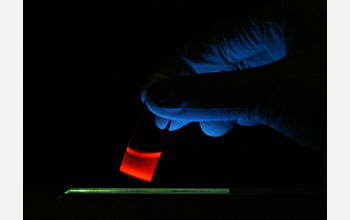Multimedia Gallery
Fluorescent Nanoparticles (Image 2)
Luminescent porous silicon nanoparticles in a vial. The vial is being illuminated with an ultraviolet ("black") light, revealing bright, red-orange photoluminescence. Prepared from high-purity silicon wafers, these nanoparticles provide a nontoxic and biodegradable alternative to conventional quantum dots for drug delivery and medical diagnostic applications. [Image 2 of 3 related images. See Image 3.]
More about this Image
Chemistry professor Michael Sailor and a team of researchers from the University of California, San Diego (UCSD), have developed a biodegradable fluorescent nanoparticle that can safely image tumors and organs in live mice, and has the potential for use in cancer detection and treatment in humans.
Until now, the use of fluorescent nanoparticles in medicine has not been possible because the organic and inorganic chemicals used to make the materials glow are toxic and cannot be put in the human body. Fluorescent semiconductor nanoparticles known as quantum dots, for example, can release potentially harmful heavy metals when they break down.
To counter this problem, Sailor's team designed a new, nontoxic quantum dot nanoparticle made from silicon wafers, the same high-purity wafers that go into the manufacture of computer chips. Researchers took the thin wafers and ran electric current through them, drilling billions of pores, then used ultrasound waves to break the wafers into bits as small as 100 nanometers. The result was spongy silicon particles containing nanoscale features capable of displaying quantum confinement effects, or so-called "quantum dots." The quantum dots in the UCSD experiment glowed a reddish color when exposed to red, blue or ultraviolet light.
Sailor and his team tested the nanoparticles in mice and found that tumors would glow for several hours, then dim as the particles degraded. The number of nanoparticles dropped noticeably after a week and they were undetectable after four weeks. A battery of toxicity tests were performed and no evidence of toxicity was found. However, the researchers stop short of concluding these new nanoparticles are completely harmless.
"Very high doses of any substance can be harmful," says Sailor. "The important conclusion from this work is that the materials are nontoxic at the concentrations we need to use to see tumors."
Sailor says that a major contributing factor to the success of their quantum dots is that they are made from silicon, which means the materials degrade into silicic acid, a form of silicon that is commonly present in the human body and that is needed for proper bone and tissue growth.
Such materials should be useful in the early diagnosis and treatment of cancer. Nanoparticles that glow can reveal tumors too small to detect by other means, and during surgery, they can allow the doctor to better find and remove all traces of a cancerous growth. In addition, they can enable targeted delivery of drugs and make it possible to use smaller, safer doses. Further research is necessary before this new material can undergo clinical trials in humans. Researchers need to further test its toxicity, how well it delivers drugs to diseased tissues, and how well it can be imaged in clinical settings.
Graduate students Ji-Ho Park and Luo Gu in Sailor's lab; Sangeeta Bhatia, bioengineering professor at the Massachusetts Institute of Technology and graduate student Geoffrey von Malzahn in Bhatia's lab; and Erkki Ruoslahti, tumor microenvironment professor at the University of California, Santa Barbara, assisted the research. This research was supported by the National Science Foundation and the National Cancer Institute. (Date of Image: 2007-2009)
Credit: Luo Gu, Ji-Ho Park, UCSD
See other images like this on your iPhone or iPad download NSF Science Zone on the Apple App Store.
Images and other media in the National Science Foundation Multimedia Gallery are available for use in print and electronic material by NSF employees, members of the media, university staff, teachers and the general public. All media in the gallery are intended for personal, educational and nonprofit/non-commercial use only.
Images credited to the National Science Foundation, a federal agency, are in the public domain. The images were created by employees of the United States Government as part of their official duties or prepared by contractors as "works for hire" for NSF. You may freely use NSF-credited images and, at your discretion, credit NSF with a "Courtesy: National Science Foundation" notation.
Additional information about general usage can be found in Conditions.
Also Available:
Download the high-resolution JPG version of the image. (1.2 MB)
Use your mouse to right-click (Mac users may need to Ctrl-click) the link above and choose the option that will save the file or target to your computer.



